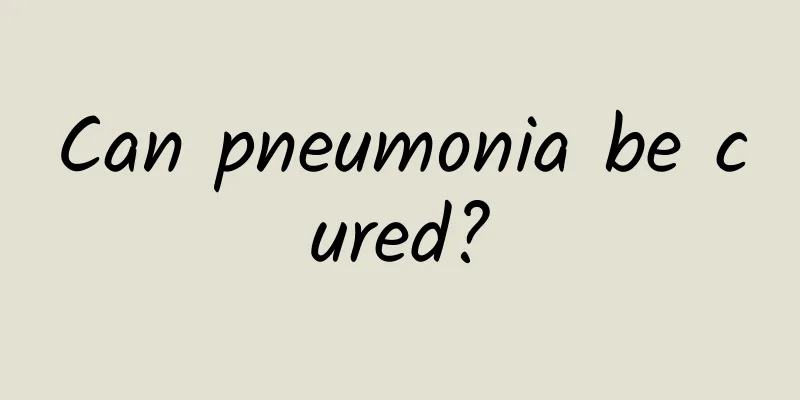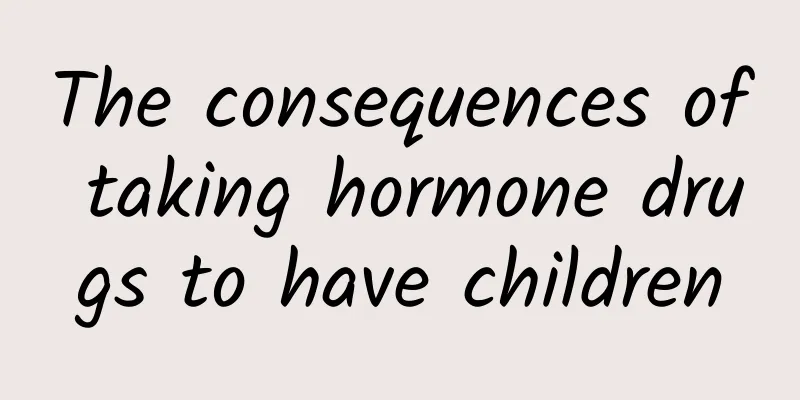Can pneumonia be cured?

|
Pneumonia is a common disease, and many parents and friends are very familiar with it. Children's coughs and sputum caused by colds lead to untimely treatment, which eventually develops into pneumonia. In the end, they must be hospitalized for infusion treatment, which brings a lot of pain to the children. So can pneumonia be cured? As long as the treatment is timely and the treatment method is appropriate, you can recover your health. Don't delay the disease. In the old society, pneumonia was an incurable disease. However, with the rapid development of medical technology today, pneumonia has become a minor disease that is easy to treat. If you have pneumonia, it is best to go to a regular hospital for treatment, and pneumonia patients need to follow the necessary course of treatment. Regarding the question of whether pneumonia can be cured, here is an answer: In addition to bed rest, drinking plenty of water, oxygen inhalation, and active expectoration, the most important part of pneumonia treatment is anti-infection. Treatment of bacterial pneumonia includes both pathogen-directed therapy and empirical therapy. The former selects antimicrobial drugs that are sensitive in in vitro tests based on the results of sputum culture and drug sensitivity tests; the latter mainly selects antimicrobial drugs that may cover the pathogens based on the epidemiological data of pneumonia pathogens in the region. In addition, the selection of antimicrobial drugs and routes of administration are based on factors such as the patient's age, underlying disease, severity of the disease, and whether there is aspiration. If pneumonia is suspected, give the first dose of antibiotics immediately. After the condition stabilizes, the intravenous route can be changed to oral treatment. The course of antibiotic treatment for pneumonia is at least 5 days, and most patients need 7 to 10 days or longer. Antibiotics can be discontinued when the body temperature is normal for 48 to 72 hours and there are no clinical unstable signs of pneumonia. The clinical stability criteria for pneumonia are: ① body temperature ≤ 37.8℃; ② heart rate ≤ 100 times/min; ③ respiratory rate ≤ 24 times/min; ④ blood pressure: systolic pressure ≥ 90 mmHg; ⑤ arterial oxygen saturation ≥ 90% or PaO2 ≥ 60 mmHg under breathing room air conditions; ⑥ able to eat orally; ⑦ normal mental state. The clinical manifestations of effective treatment include a decrease in body temperature, improvement in symptoms, a stable clinical state, a gradual decrease in white blood cell count or its return to normal, and delayed absorption of lesions on chest X-rays. If symptoms do not improve after 72 hours, the possible reasons may be: ① The drug fails to cover the pathogenic bacteria, or the bacteria are resistant to the drug. ②Infection by special pathogens such as Mycobacterium tuberculosis, fungi, viruses, etc. ③ Complications occur or host factors that affect efficacy (such as immunosuppression) exist. ④ Non-infectious diseases are misdiagnosed as pneumonia. ⑤Drug fever. It needs to be carefully analyzed, necessary inspections made, and appropriate treatments taken. 1. Community-acquired pneumonia in young adults and those without underlying diseases Penicillin, first-generation cephalosporins and other antibiotics are used. Because the resistance rate of Streptococcus pneumoniae to macrolide antibiotics in my country is high, macrolide antibiotics are not used alone to treat pneumonia caused by this bacteria. Fluoroquinolones (moxifloxacin, gemifloxacin and levofloxacin) that are specifically effective for respiratory tract infections can be used for resistant Streptococcus pneumoniae. 2. Elderly people, those with underlying diseases or those with community-acquired pneumonia who require hospitalization Fluoroquinolones, second/third generation cephalosporins, β-lactams/β-lactamase inhibitors, or ertapenem can be used in combination with macrolides. 3. Hospital-acquired pneumonia Second/third generation cephalosporins, β-lactam/β-lactamase inhibitors, fluoroquinolones or carbapenems were used. 4. Severe pneumonia Broad-spectrum, powerful antibiotics are preferred, in sufficient doses and in combination. The mortality rate of patients with insufficient or unreasonable initial empirical treatment and subsequent adjustment of antimicrobial drugs based on etiological results is higher than that of patients with correct initial treatment. For severe community-acquired pneumonia, β-lactams combined with macrolides or fluoroquinolones are used; for those allergic to penicillin, fluoroquinolones and aztreonam are used. Hospital-acquired pneumonia can be treated with fluoroquinolones or aminoglycosides combined with any of the antipseudomonal β-lactams, broad-spectrum penicillins/β-lactamase inhibitors, or carbapenems, and, if necessary, with vancomycin, teicoplanin, or linezolid. There are different answers to the question of whether pneumonia can be cured. It mainly depends on the patient's condition and physical fitness. Many patients delay their illness, leading to severe pneumonia, which can easily cause lung infection, making it very troublesome to treat. Pneumonia treatment must be thorough, and the treatment course must be strictly followed. Don't get bored, and maintain a good attitude. |
Recommend
The efficacy and function of wild chrysanthemum leaves
In our lives, many people like to see wild chrysa...
Is plum blossom rash contagious?
When it comes to infectious diseases, many people...
What to do if you have toothache one year after filling
In daily life, many people do not pay attention t...
What happens if a teenager ejaculates too much?
Adolescents are in a state of curiosity about var...
Calf soreness during pregnancy
For women, pregnancy is a period full of expectati...
Will false labor cause abdominal pain?
As the fetus continues to grow in the mother'...
What is the difference between influenza and the common cold?
Influenza and the common cold both show symptoms ...
What medicine can help hair growth?
The increase in life pressure has caused many peop...
Facial nerve injury
We all know that the brain is an extremely import...
High immature granulocyte ratio
When the percentage of immature cells increases in...
Kidney deficiency and nephritis are different diseases
Are "kidney deficiency" in traditional ...
Eczema treatment, the most effective treatment
The itching caused by eczema is very painful. Man...
Involuntary hand twitching
Some middle-aged and elderly people suffer from i...
Can I have sex with trichomoniasis?
If you have Trichomonas vaginitis, you should see...
Central nervous system diseases
Many people do not understand the concept of the ...









